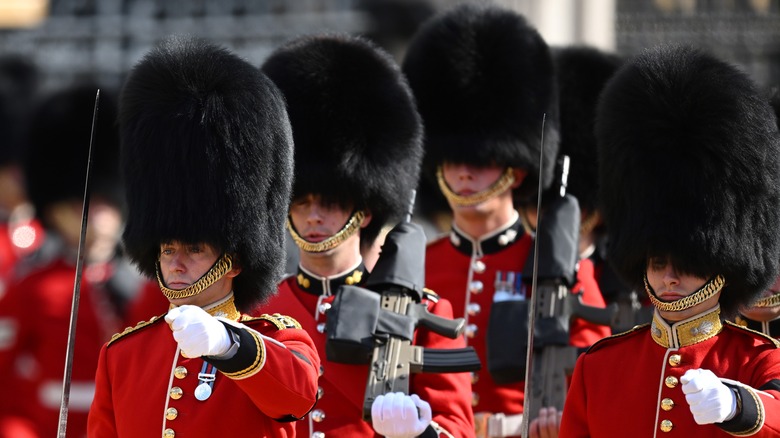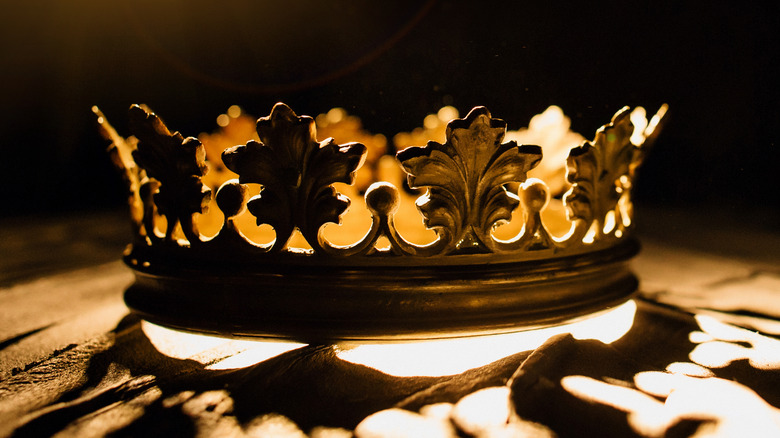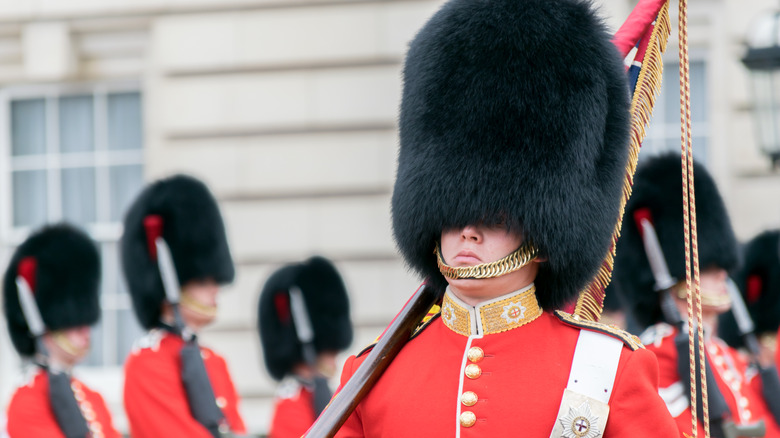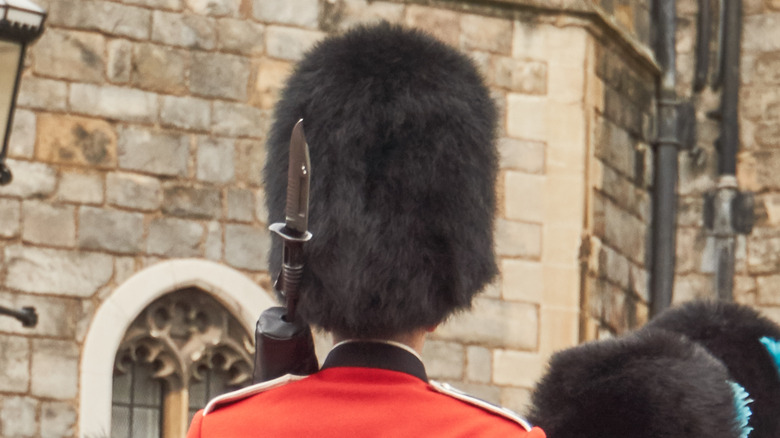Inside The Duties Of A Royal Guard's Shift
You've seen it in movies plenty of times: An insolent group of tourists swarms around some poor old royal guard who's charged with the task of standing at attention in front of Buckingham Palace through thick and thin, neither batting an eye nor moving a muscle despite how many times he's heckled and tried by civilians. People seem mesmerized by the phenomenon of royal guards remaining steadfast in their unwavering demeanor like (barely) sentient statues dressed in red coats. And how about those funny hats that look like big, furry, black thumbs? All of it might seem comical, but there's actually a lot that goes into being a Queen's Guard that makes it a rather difficult and venerable job.
According to Reader's Digest, royal guards are charged with numerous tasks that prepare them for their long-standing (no pun intended) work as protectors of the royal family. Ergo, if you ever take a trip to Buckingham Palace, you might want to refrain from treating them like a circus act, because it's a hard job that's worthy of respect.
The British Army Recruit Battery test
Before they adorn themselves in thick scarlet uniforms and big black hats, royal guards are required to pass the British Army Recruit Battery test (or BARB). Military Aptitude Tests reports that the BARB is designed to weigh the cognitive and orientation skills and numeric fluency of prospective royal guards. How they fare throughout the elaborate series of questions will determine where they serve and under what circumstances. Additionally, the BARB evaluates how well potential guards perform under pressure. The test is designed to push their critical thinking skills to the threshold.
The test is delivered online and is divided into five different sections that the recruits must navigate through before even being considered for a position among the royal guard. Honing in on a potential candidate's strengths and weaknesses is an essential component in ascertaining who is best suited for the task of defending the queen and her family, so if you're looking to take up with those devout warriors who stand outside of Buckingham Palace with such grace, be prepared to hit the books first (via Military Aptitude Tests).
Do royal guards really protect the queen?
You might be wondering, through all of the testing and standing at attention and observing of everything, if royal guards are actually there to protect the queen and her family. Officially, those guards clad in red tunics and black hats are called Foot Guards, as Project Britain reports, and their position within the royal circle is more or less ceremonial above all. Whenever the queen is present, there are no less than four Foot Guards stationed outside the facility at all times (two when she is elsewhere), and though they are known to carry swords and rifles as part of their uniform, the firearms aren't actually loaded unless there's a clear and present threat looming over the city (per Reader's Digest).
Don't get anxious, though. According to Project Britain, the royal family has personal bodyguards present at all times, and Buckingham Palace has its own private police force as well. You can rest assured knowing that the monarchy is properly guarded every minute of every day.
How long do royal guards stay on duty?
Generally speaking, royal guards hold post for two hours at a time, with four-hour intervals in between. If that seems like a leisurely work day, bear in mind that they are required to stand completely still for the majority of it. For a minimum of 10 minutes at a time, Foot Guards must remain frozen stiff like scarlet effigies. Only then are they allowed to relocate to a different part of the courtyard before their silent and unflinching watch begins again (via Project Britain). Think about it: Could you really go two straight hours without scratching your itchy nose?
A limited range of motion for long periods of time is liable to weigh on you, so guards typically opt to move around as much as possible. However, relocation is limited to 10 paces in any given direction, as Reader's Digest reports. "It's best to do this every 10 minutes or so to stop yourself from fainting from the blood that gets trapped in your legs," one Foot Guard anonymously shared via a Reddit Q&A forum.
Heavy lies the crown (and hat)
One more thing worth noting: Those funny hats that royal guards wear are hardly a laughing matter. According to Live Science, there were originally intended to inspire intimidation on the battlefield some two centuries ago. "The idea was that you made your foot soldiers look taller and therefore more fearsome," said royal commentator Richard Fitzwilliams. "They used to fulfill a practical need for a foot soldier in battle. They were used when fighting the French in the Napoleonic wars. In fact, Napoleon's Imperial Guard wore them, too."
While their overall backstory commands respect, so does the practice of wearing them. As Reader's Digest reports, the bearskin headpieces that royal guards are required to wear weigh around nine pounds at their heaviest. The human head alone can weigh up to 13 pounds (per Science Focus), so it's kind of like standing perfectly still with a whole other head balanced on top of the one you already have for two hours at a time. It probably goes without saying that it can take a serious toll on your neck if you're not careful.




